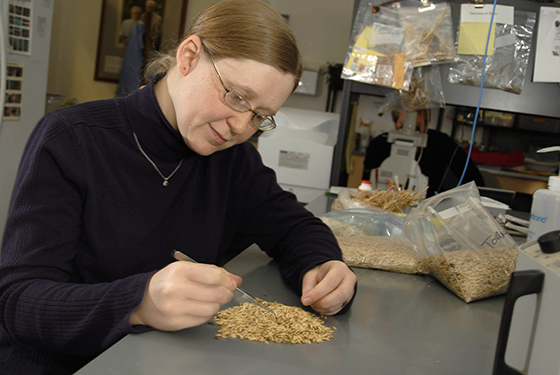Bozeman, Montana, USA
July 10, 2014

Mary Burrows, looking here for ergot bodies in wheat seed, is director of a new project that will establish a Pulse Crop Health Diagnostic Laboratory at Montana State University. (MSU photo by Kelly Gorham).
Work is beginning this summer to establish a regional laboratory at Montana State University for diagnosing insects, diseases and weeds in pulse crops.
Chickpea, dry pea and lentil growers should be able to send samples to the lab this fall, said MSU Extension Plant Pathologist Mary Burrows, who is directing the project. Space previously occupied by the MSU Extension Water Quality program will be remodeled and turned into a “clean” laboratory this summer. Burrows hopes to hire a lab supervisor/scientist by September.
The Pulse Crop Health Diagnostic Laboratory will be located in Marsh Lab along South Nineteenth Avenue in Bozeman. Funding came through the 2014 Farm Bill, which provided $150,000 for the lab through its “Plant Pest and Disease Management” programs.
“Since very few pulse pathogens have accredited tests, this laboratory will be a leader in developing routine diagnostic methods for pulse crops, which can be extended to other legume plant species,” Burrows said.
“We are very happy to be able to offer this service for growers,” she added.
Gary D. Adams, state plant health director for the USDA’s Animal and Plant Health Inspection Service, Plant Protection and Quarantine (APHIS, PPQ) in Montana, said, “The funding represents our commitment to partner with our stakeholders to achieve our mutual goals of identifying and responding to invasive pests and diseases that pose a threat to American agriculture and increasing public involvement in our efforts to stop their spread, all while keeping export markets open for U.S. products.
“Cooperators from Idaho, Nebraska, North Dakota, South Dakota and Washington all know there is a need and support this lab to protect this growing industry,” Adams added. “Acreage of these crops has significantly increased in the last 10 years, particularly with dry pea, where 338,000 acres were planted in 2003 and 840,000 acres were planted in 2013.”
Burrows said Montana, Idaho, Nebraska, North Dakota, Oregon, South Dakota and Washington are the main pulse crop-growing states in the country, with 80 percent of their grain going overseas.
Growing demand, price supports and the explosion in using pulse crops to fill fallow acres are responsible for the increase, Burrows said. Wheat growers, especially in the area of Montana known as the “Golden Triangle,” are planting pulse crops during fallow years because they don’t require a lot of water, they break the life cycles of pests, and they increase farm income.
Shannon Berndt, executive director of the Northern Pulse Growers Association, said Montanans grew pulse crops many years ago, but the acreage has increased steadily since 1997. Sometimes the market favors lentils. Other times, it’s dry peas. But in the past three or four years, the demand for chickpeas has been strong because of the popularity of hummus snack food. Chickpeas are a major component of hummus.
Berndt and others said MSU research has also played a significant role in the growth of Montana’s pulse crop industry.
“We are very grateful and depend upon the research going on at MSU,” said David Oien, organic farming pioneer and co-founder of Timeless Seeds Inc. in Ulm. “The research being done is especially valuable to the new growers that grow for us, the next generation returning to family farms.”
Berndt said, “The research being done at MSU currently is extremely important to the continued growth of acreage in Montana.”
She added that the new lab “will really play an integral role in better varieties, and it will open up additional marketing opportunities.”
As the number of pulse crop acres grows, issues involving disease, pest management and weed control will become increasingly important, Berndt said. Burrows specifically mentioned issues involving viruses, fungi, bacterial and nematode diseases.
“Traditional and molecular diagnostic tools are needed to discriminate between pest species, help us monitor the crop for new diseases and to detect and eliminate pests of concern,” Burrows said.
Berndt noted that Burrows took the initiative to establish the new lab and said MSU’s central location is ideal for serving pulse crop growers from North Dakota to Washington. Burrows added that the idea of setting up a regional pulse crop lab at MSU took the cooperation of several entities. In addition to APHIS-PPQ in Montana and the Northern Pulse Growers Association, those groups were the Montana Department of Agriculture, Montana Seed Growers and the U.S. Dry Pea and Lentil Council.
Once it’s running, the pulse crop lab will work closely with other MSU laboratories, Burrows said. Among them will be the Schutter Diagnostic Laboratory of which she is director. The Schutter lab already diagnoses plant diseases and pests, but Burrows said it isn’t equipped to handle plant diseases and pests that are specific to pulse crops. The Montana State Seed Lab focuses mostly on wheat and grasses.
The new lab will also be available to assist other laboratories when they have a large number of samples they need to screen, Burrows said.
Ron Larson, manager of the Montana Seed Growers Association and interim manager of the Montana State Seed Lab, said the state seed lab currently cooperates with the Schutter Diagnostic Lab on pulse crop ascochyta disease testing, and he believes the regional pulse lab will offer more opportunity for producers to get answers to new pest and disease issues that have shown up in Montana, neighboring states and Canada.
“The opportunity to offer a well-staffed and adequately funded research lab that is ready to deal with new diseases and pests presents a very proactive benefit to the pulse industry as it continues to develop in Montana and the surrounding states,” he said. “New lab tests that could become routine could be transferred to the commercial side of the lab while the research portion continues to deal with new challenges.”